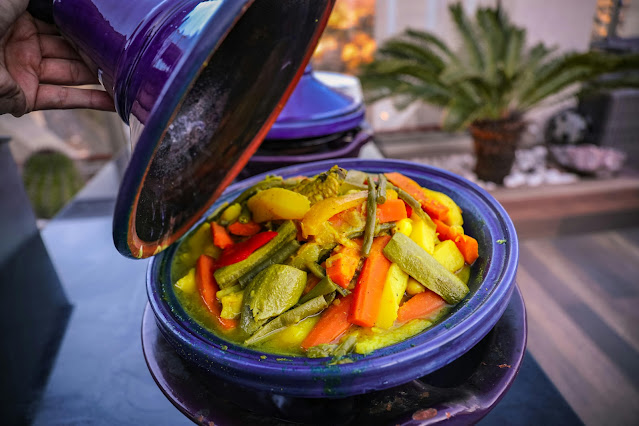Tagine: The Heart of Moroccan Stewed Cooking
Tagine, a symbol of the Moroccan culinary way of life, refers not only to the flavorful stews organized inside but also to the particular earthenware vessel wherein they are gradual-cooked. This vital dish represents a mix of cultural effects and is widely known for its rich flavors, colorful hues, and deeply fragrant spices. Central to Moroccan delicacies, the tagine offers a warm and communal eating experience where food is shared with own family and friends, reflecting the hospitality and historical past of the area.
The Essence of Moroccan Cuisine
Moroccan cuisine is a reflection of the u. S .’s numerous records and geographic position on the crossroads of Berber, Arab, and Jewish cultures. Known for its Mediterranean roots, Moroccan cooking includes various elements and strategies. Like its neighboring Maghreb international locations, Algeria and Tunisia, Morocco shares many culinary traditions, which includes Couscous, Méchoui, and, of route, the beloved tagine. This cooking technique highlights the united states’s love for slow-cooked, flavorful dishes, that could vary substantially depending on the vicinity or maybe the circle of relatives getting ready it.
Tagine: From Cooking Vessel to Iconic Dish
The tagine, also spelled tajine, takes its name from the specific clay pot used to put together these scrumptious stews. This pot, which consists of a extensive, shallow base and a conical lid, performs a critical function in cooking. The lid lets in steam to upward push and condense, slowly basting the ingredients during cooking. The end result is a dish this is wealthy in taste, as the elements simmer gently of their own juices, concentrating the spices and aromas. The technique of cooking in a tagine is as important because the very last dish itself, with the vessel being positioned at once at the middle of the desk for a communal meal. Diners historically use pieces of flatbread to scoop up the meals, making the meal an interactive and intimate enjoy.
A Variety of Tagine Recipes
Tagines are surprisingly versatile, and their components vary according to season, place, and event. Meat-primarily based tagines are common, with lamb, pork, or meatballs regularly marinated in a rich mix of spices before cooking. Popular spices encompass cumin, coriander, turmeric, ginger, and cinnamon, giving each dish a different and aromatic profile. Vegetable tagines are similarly prized, with seasonal produce like carrots, zucchini, and bell peppers taking middle stage. Additionally, clean and dried culmination like apricots, dates, and prunes are often introduced, lending a sweet evaluation to the savory elements of the dish. These mixtures of meat, greens, and end result showcase the depth and stability of Moroccan flavors, supplying a complicated but harmonious flavor with every bite.
How to Prepare a Traditional Tagine
Preparing a traditional Moroccan tagine is an exercise in patience and precision. The method begins by marinating the beef, allowing the spices to penetrate and decorate the flavor. Once the beef is prepared, it's miles placed at the bottom of the tagine pot, layered with chopped vegetables and any chosen fruits. A small quantity of water and a drizzle of oil are then brought to ensure moisture all through the cooking manner. The key to a successful tagine is low and slow cooking. The pot is placed over very low warmness, permitting the elements to simmer for numerous hours. This gradual approach ensures that the meat becomes tender and the greens soak up the spices fully. One of the crucial policies of tagine cooking is to face up to the temptation to lift the lid in the course of the cooking technique, as this will allow the steam and aromas to get away, reducing the overall taste.
The Role of Kémia in Tagine Meals
A tagine meal is often accompanied via small dishes known as kémia, that are usually made from cooked veggies. These side dishes serve to enhance the flavors of the principle meal and upload range to the eating revel in. While the tagine is the famous person of the display, kémia brings an brought measurement of texture and flavor, creating a properly-rounded meal that satisfies the palate.
Tips for Cooking with Tagines
While tagines are designed to resist the sluggish-cooking process, not all tagine pots are created identical. It is vital to make certain that the tagine used for cooking is appropriate for high warmness. Some ornamental tagine dishes are meant solely for serving and cannot withstand the high temperatures required for cooking. Always select a functional, warmth-resistant tagine to avoid any mishaps at some stage in practise. Additionally, for those who won't personal a conventional tagine pot, a heavy-bottomed Dutch oven may be used as an alternative, though the unique taste and aroma created with the aid of the clay pot won't be absolutely replicated.
A Dish of Warmth and Tradition
At its center, the Moroccan tagine represents more than simply meals; it symbolizes culture, own family, and a manner of lifestyles. The gradual-cooking approach, the aromatic combination of spices, and the communal nature of the meal all make a contribution to the unique revel in of dining on a tagine. Whether served in a domestic or at a eating place, it reflects the generosity and heat of Moroccan tradition, bringing people together over a shared table. The versions in substances and strategies from location to region show off the wealthy tapestry of Morocco’s culinary background, making the tagine a versatile and cherished dish.
Conclusion: The Timeless Appeal of Tagine
The tagine is a testament to the intensity and variety of Moroccan cuisine, a dish that is deeply rooted in records and subculture. With its complex flavors, sluggish-cooked tenderness, and emphasis on shared meals, the tagine continues to captivate each locals and visitors alike. Whether made with meat, greens, or end result, every tagine gives a unique blend of aromas and tastes, making every meal a memorable event.


